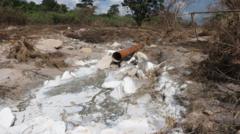Is Zambia Right to Dismiss US Health Warnings After Toxic Copper Mine Spill?

Overview of the Pollution Concerns in Zambia's Copperbelt Region
The Copperbelt region of Zambia, known for its rich mineral resources, has been under scrutiny recently due to rising concerns about pollution. The US embassy issued a health alert that has sparked debates about environmental safety and public health in the area. Following a significant incident in February, where a tailings dam at the Sino-Metals mine collapsed, the situation has escalated, leading to fears of contamination in local water and soil. As the Zambian government moves to dismiss these claims, the conversation around mining practices, environmental responsibility, and community health continues to grow.
The February Incident: A Timeline of Events
In February, heavy rains led to the collapse of a tailings dam at the Sino-Metals mine, releasing toxic waste and heavy metals into the Kafue River. This river is a crucial drinking water source for many communities in the region. The immediate aftermath raised alarms about the potential health risks posed to residents and local ecosystems. Here’s a brief timeline of the events that followed:
- February: Tailings dam collapse occurs during heavy rainfall, contaminating the Kafue River.
- March: Initial assessments begin, but concerns about long-term health effects start to surface.
- June: The US embassy issues a health alert, urging the withdrawal of personnel from Kitwe and surrounding areas.
- September: Zambian government officials claim that laboratory results indicate water safety has returned to normal.
US Embassy's Health Alert: What It Means
The health alert from the US embassy was a significant development, highlighting serious concerns about contamination. The embassy reported "widespread contamination of water and soil," which they linked directly to the February spill. This alert prompted immediate action from the embassy, prioritizing the safety of its personnel in the region.
According to the embassy's statement, new information indicated the presence of hazardous and carcinogenic substances in the vicinity of the spill. The warning extended beyond water and soil, suggesting that airborne contaminants could pose additional health risks if inhaled. This multifaceted threat raised serious questions about environmental monitoring and public health strategies in Zambia.
Zambian Government's Response: Safety Reassurances
In contrast to the US embassy's alarming notifications, the Zambian government, led by spokesperson Cornelius Mweetwa, has been steadfast in asserting that the situation is under control. Mweetwa reported that laboratory tests showed that pH levels in affected areas have returned to normal, and claimed that the water is now safe to drink.
He emphasized that there are no serious implications for public health, agriculture, or the environment, urging citizens not to panic. This response raises important questions about the contrasting narratives between the Zambian government and international entities such as the US embassy.
The Role of Sino-Metals Leach Zambia Mine
Sino-Metals, a subsidiary of the China Nonferrous Metal Mining Group, has faced significant scrutiny since the incident. Following the spill, the company pledged to compensate affected communities and restore the environment. However, the effectiveness of these promises remains a topic of debate among local stakeholders.
The mining industry in Zambia is pivotal to the economy, but it also presents substantial environmental challenges. The spill at Sino-Metals has highlighted the need for comprehensive regulations and accountability measures to prevent similar incidents in the future.
Impact on Local Communities and Agriculture
The spill has had a profound impact on local communities, particularly for farmers who depend on the Kafue River for irrigation. As water quality deteriorated, agricultural yields were threatened, raising concerns about food security in the region.
Moreover, the spill affected aquatic life, leading to a ripple effect on the ecosystem. Communities that rely on fishing as a source of livelihood faced disruptions, further exacerbating economic challenges in the area. The need for immediate and effective remediation efforts has become increasingly urgent as the local population grapples with the fallout from the disaster.
Government Measures and Public Communication
The Zambian government has stated that it has been proactive since the February incident, consistently updating the public on the situation. Green Economy Minister Mike Mposha emphasized the government's commitment to transparency and safety, while Minister of Water Development Collins Nzovu assured citizens that water testing is ongoing and meets World Health Organization standards.
This proactive stance is vital in restoring public trust. However, the government must also address the concerns raised by the US embassy and local environmental activists, who argue that more decisive action is needed to protect citizens and the environment.
Opposition Voices and Geopolitical Implications
Political opposition has emerged in response to the US embassy's health alert. Green Party leader Peter Sinkamba suggested that the embassy's warning is influenced by geopolitical dynamics, questioning the timing of the alert. He accused the embassy of neglecting other environmental issues, such as lead poisoning linked to Western mining companies.
This viewpoint underscores the complexities of environmental governance in Zambia, where international interests and local realities often collide. The need for a balanced approach that prioritizes public health while considering economic factors is critical in navigating these challenges.
Voices from Environmental Activists
Environmental advocates like Maggie Mapalo Mwape, the executive director of the Centre for Environment Justice, have called for immediate action to address the pollution crisis. Mwape labeled the situation a national disaster, emphasizing the importance of protecting the rights and well-being of Zambian citizens.
Activists are pushing for concrete measures to mitigate the effects of the pollution and to prevent future occurrences. They argue that the government must take decisive action to ensure that mining practices are sustainable and do not jeopardize public health or the environment.
Conclusion: The Path Forward for Zambia
The situation in Zambia's Copperbelt region highlights the intricate balance between economic growth through mining and the imperative of environmental stewardship. As the government and mining companies navigate the aftermath of the spill, it is crucial to prioritize the health and safety of local communities.
Moving forward, transparency, accountability, and community engagement will be essential in rebuilding trust and ensuring that similar incidents do not occur in the future. The collaboration between government agencies, mining companies, and civil society will determine the effectiveness of response efforts and the protection of Zambia's rich natural resources.
FAQs
What caused the tailings dam collapse at Sino-Metals mine?
The tailings dam collapsed due to heavy rainfall, which led to an overflow of toxic waste and heavy metals into the Kafue River, significantly affecting water quality in the region.
How is the Zambian government addressing the pollution concerns?
The Zambian government claims to be actively monitoring water quality and has stated that laboratory results show that pH levels have returned to normal, indicating that the water is safe to drink.
What impact did the spill have on local communities?
The spill has threatened agricultural yields, disrupted fishing livelihoods, and raised concerns about food security among local communities that rely on the Kafue River.
What actions are environmental activists calling for?
Environmental activists are urging the government to take decisive action to mitigate the effects of the pollution and to implement sustainable mining practices to protect public health and the environment.
The situation in Zambia’s Copperbelt region raises critical questions about the balance between economic development and environmental protection. As stakeholders navigate these complex challenges, the commitment to safeguarding the health and well-being of local communities must remain paramount. Will Zambia emerge from this crisis with stronger regulations and a renewed focus on environmental responsibility? #Zambia #Copperbelt #EnvironmentalSafety
Published: 2025-08-07 15:18:13 | Category: world



